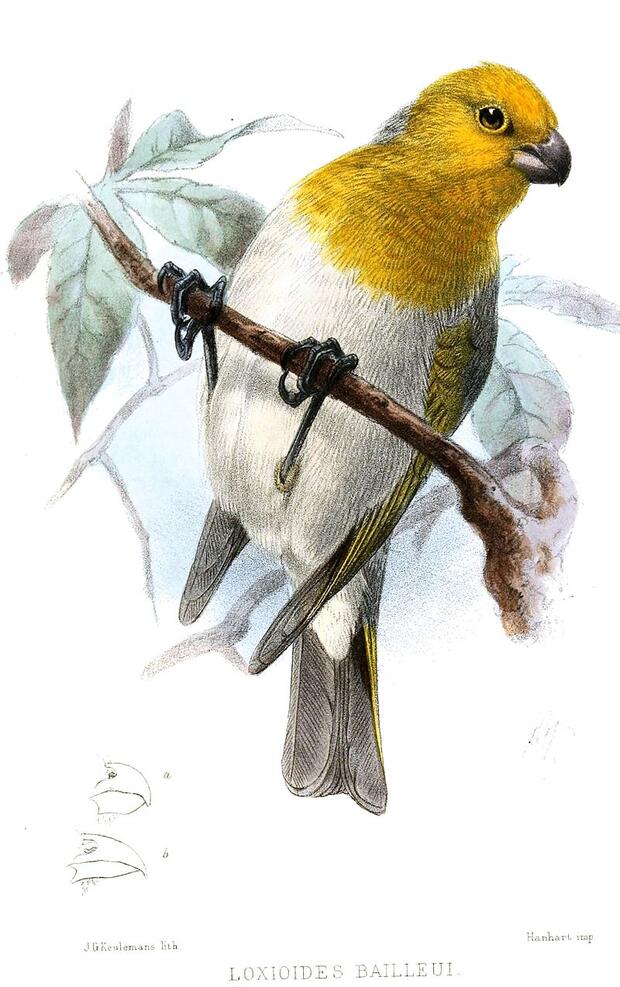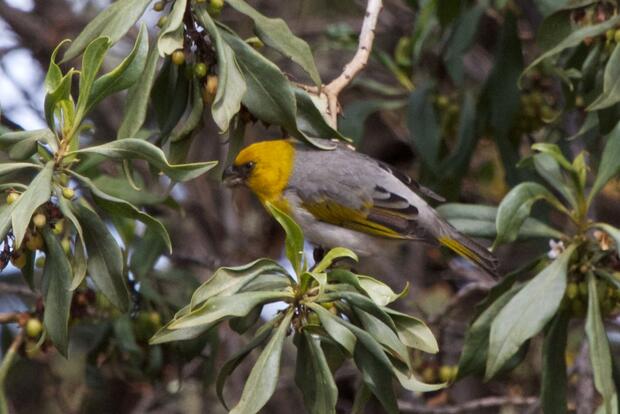- Trial Court Law Libraries
“[The Palila] wings its way into the federal court as a plaintiff in its own right.”
With these words in 1988, the U.S. Court of Appeals of the 9th Circuit gave hope to animal rights supporters everywhere that animals could finally sue on their own behalf for their own welfare and survival, regardless of competing desires by humans, and without the need for a human being to claim personal or property damages.
The case was Palila v. Hawaii Department of Land and Natural Resources, 852 F. 2d 1106 (U.S. Court of Appeals, 9th Circuit, 1988). The bird species Palila (an endangered species) was cited as the plaintiff (along with others: Sierra Club, National Audubon Society, Hawaii Audubon Society, Alan C. Ziegler) challenging an action under the Endangered Species Act. The Department of Land and Natural Resources had, for the benefit of hunters, been allowing feral sheep and goats to graze in the endangered bird’s only habitat, on the slopes of Mauna Kea on the island of Hawaii, and to eat its preferred food, thus endangering the Palila’s survival as a species. The court ordered the Department to remove the goats and sheep from the bird’s habitat.
A fuller quotation of the court’s words reads:
“As an endangered species under the Endangered Species Act…the bird (Loxioides bailleui), a member of the Hawaiian honeycreeper family, also has legal status and wings its way into the federal court as a plaintiff in its own right. The Palila (which has earned the right to be capitalized since it is a party to this proceeding) is represented by attorneys for the Sierra Club, Audubon Society, and other environmental parties…”
In this case, the Palila’s standing to sue was not challenged by the defendants (and the court did not rule on that issue).
Animal species have been named as co-plaintiffs in several other cases in which they were joined by human plaintiffs, as in the Palila case.
However, as the court commented in a 1993 case in Massachusetts, Citizens to End Animal Suffering & Exploitation v. New England Aquarium, 836 F. Supp. 45 (United States District Court for the District of Massachusetts, 1993):
“[I]n Palila, the defendants did not challenge the propriety of having an animal as a named plaintiff. Similarly, animal species have remained named plaintiffs in other cases in which the defendants did not contest the issue. See Mt. Graham Red Squirrel v. Yeutter, 930 F.2d 703 (9th Cir.1991); Northern Spotted Owl v. Lujan, 758 F.Supp. 621 (W.D.Wash.1991); Northern Spotted Owl v. Hodel, 716 F.Supp. 479 (W.D.Wash.1988).
However, in the only reported case in which the naming of an animal as a party was challenged, the court found that the animal did not have standing to bring suit. In Hawaiian Crow (‘Alala) v. Lujan, No. 91–00191–DAE (D.Haw. Sept. 13, 1991), the court ruled that the ‘Alala, an endangered species of birds, did not have standing to maintain a suit challenging the implementation of a program under the Endangered Species Act (“ESA”). The court, while recognizing the authority cited above [i.e., the Palila case], denied the ‘Alala standing on the bases that: (1) the ESA provided for citizen suits brought by “persons;” (2) the other named parties—various Audubon Societies—could obtain the relief sought; and (3) F.R.Civ.P. 17(c) which provides for suits on behalf of infants or incompetent persons does not apply to animals.”
The 9th Circuit Court of Appeals, in 2004, had the last word on its previous comments about Palila:
“In context, our statements in Palila IV were little more than rhetorical flourishes. They were certainly not intended to be a statement of law, binding on future panels, that animals have standing to bring suit in their own name under the ESA.” Cetacean Community v. Bush, 386 F 3d 1169, 1174 (U.S. Court of Appeals, 9th Circuit, 2004)
Today, the Palila, still endangered, occupies 10% of its original habitat. The ‘Alala (Hawaiian Crow) is extinct in the wild; attempts to reintroduce it from a small breeding population in the San Diego Zoo have been unsuccessful.
Written by Gary Smith


